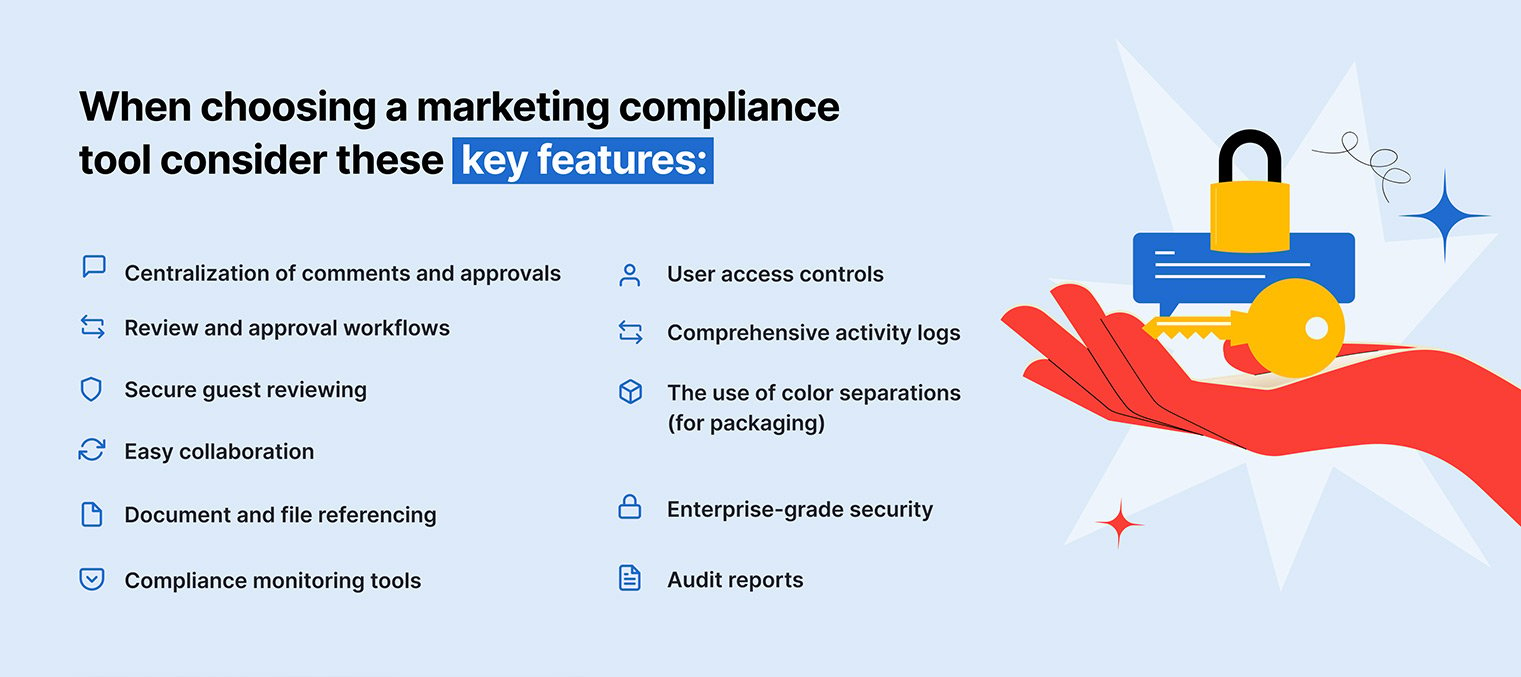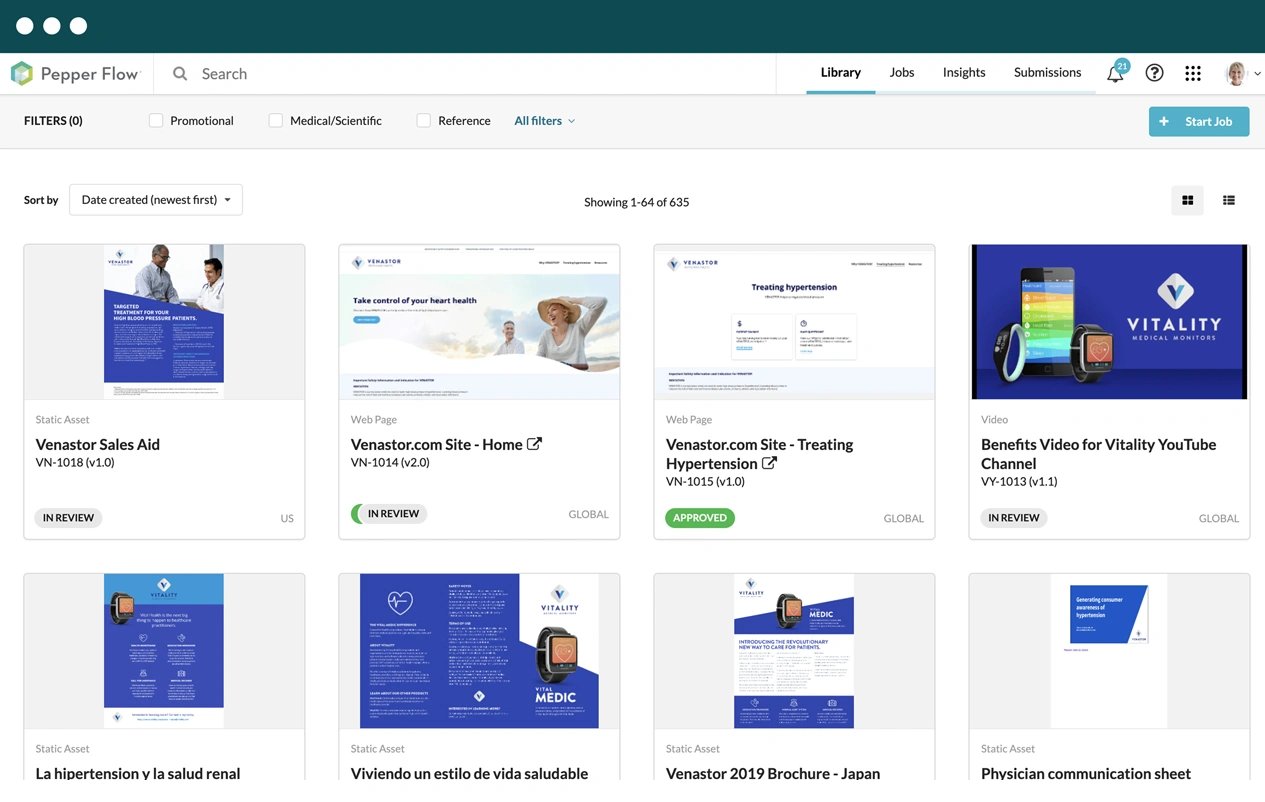There’s a world where marketing teams have plenty of time to complete creative work, a small number of assets to juggle, and one final, absolute moment where deliverables are checked for regulatory compliance.
Unfortunately, you and your creative team live on Earth. You have to move at whip-like speeds under tight deadlines with many different assets, often across multiple campaigns. At any point in that process, a compliance slipup can occur, and if it does, prepare to pay hefty fines and suffer damage to your brand.
You can eliminate the threat of dropping the compliance ball with tools tailored for creative teams like yours. Even if you already have some form of compliance tool in place, you may have gaps that you didn’t even know about (eg. auditing or collaboration), and could save yourself a lot of time and heartache with what we’ve put together below.
So let’s look at what makes a great compliance tool, and 7 of the best we’ve hand-picked for the job.
What we'll cover
Table of contents
Essential features to look for in compliance management tools

When hunting for the perfect compliance management tool, there are several features you should keep an eye out for:
Centralization of comments and approvals
Here’s a terrible situation you might know something about: a creative workflow where every piece of feedback, every nod of approval or request for revision, across all types of creative assets, is scattered across emails, shared drives, and Slack threads. Notes just tend to slip through the cracks. And the FTC won’t take, “my designer didn’t see a comment,” as an excuse.
Compliance management tools wrangle all of these comments and approvals into a central, meticulously managed space that’s accessible at any moment from anywhere. There’s always a straight path from conception to final deliverable, as opposed to a branch-like journey.
Review and approval workflows
Customizable review and approval workflows in compliance management are essential. Your marketing needs and requirements shouldn’t have to fit the limitations of a tool. Besides, there are many industries, like healthcare, that have specific review and approval steps that you have to follow. By automating and standardizing the review process, you not only ensure consistency across all content but also embed regulatory and brand standards into the DNA of your operations.
Secure guest reviewing
Data breaches aren’t some abstract concept happening to only the most careless companies—they’re real, and they’re a constant threat to everyone. And that threat increases as you bring in outside reviewers for feedback. Solid compliance tools not only verify the identity of external reviewers, but they fortify your review process, safeguarding the integrity of your marketing efforts against things like network vulnerabilities or outdated software.
Easy collaboration
Compliance may seem like a “buck stops here” situation, but it’s really a collaborative endeavor. It requires many voices, each contributing their unique perspective towards solving issues and achieving a common goal. You need a compliance tool that allows effortless collaboration, and turns problem-solving into a dialogue rather than a monologue.
Document and file referencing
The ability to effortlessly link, organize, store, and retrieve essential reference documentation is something you never think about, until a regulatory body asks for it and suddenly you’re scrambling. Compliance tools create a nexus where every proof brief and comment is connected to tangible evidence. Take, for instance, a marketing campaign for a new pharmaceutical product. The claim of medical efficacy isn't just a statement—it's a declaration backed by rigorous research and documentation. The capability to reference these documents directly within the compliance tool streamlines the validation process, making compliance less of a hurdle and more a part of the creative workflow.
Compliance monitoring tools
Tools like checklists and electronic signatures transform the abstract concept of adherence into something tangible and manageable. Checklists serve as the blueprint for compliance, ensuring no regulatory issue is left unresolved. Electronic signatures add a layer of verifiability and intent, making every approval or decision an accountable action.
User access controls
A robust compliance framework is built on stringent user access controls. These controls are the guardians at the gate, ensuring that only those with the right credentials can view or approve sensitive compliance information. You have to be certain that the person reviewing the asset is the one meant to do so, thereby maintaining the integrity of the review process.
Comprehensive activity logs
Comprehensive activity logs offer a chronological receipt of every action taken within the system, providing an auditable trail that's invaluable for internal reviews and regulatory inspections. It might sound odd, but logs basically tell the story of the creative asset — each one is part of its compliance journey, offering insights and transparency.
The use of color separations (for packaging)
This technique, essential for producing accurate and vibrant packaging, underscores the importance of precision in compliance. It elevates the quality and integrity of the final product. If your packaging is inconsistent, not only are you throwing money away, but you risk damage to your brand’s reputation as well.
Enterprise-grade security
We can’t stress enough how important professional IT certifications and compliance certificates like SOC2 Type II, ISO 27001, and FDA 21 CFR Part 11 really are. They’re more than a badge you brag about on social media — they shield against cyber threats and compliance breaches. And these certifications ensure that electronic signatures, which are critical to marketing compliance, follow the set standards of regulatory bodies like the FDA.
Audit reports
Audit reports serve as meticulous chronicles of every compliance action taken. They cut through the opacity of processes, and lay bare the decisions, revisions, and approvals that define a project's adherence to standards. They’re what is expected when we talk about transparency and accountability. GDPR, SOC 2, or any number of organizations will need these audits to determine whether your company is compliant with all relevant laws, rules and regulations.
Types of compliance tools
Marketing compliance platforms
We consider marketing compliance platforms to be an all-inclusive solution designed to streamline the process of ensuring that your creative marketing materials meet both legal standards and brand guidelines. Whether it's reviewing advertising copy for regulatory compliance in the healthcare industry or ensuring that social media posts align with brand voice, these platforms act like the command center for compliance efforts. They coordinate reviews and approvals with precision and efficiency.
Digital asset management (DAM) platforms
A Digital Asset Management platform functions much like a meticulously organized library, cataloging and storing creative materials in a central place. In addition to safekeeping your work, it gives your creative ops instant access to the right version of an asset when it’s needed, which gives you the peace of mind that you have consistency and compliance across all marketing channels.
Content management systems (CMS)
The Content Management System is the spine of any digital presence, from websites to blogs and beyond. Content comes to life in a CMS, and is shaped and molded for public viewing. But don’t let the creative exterior fool you — they have a rigorous adherence to compliance, whether through ensuring accessibility standards are met or that content publishing workflows incorporate necessary approvals.
Marketing analytics and reporting tools
The world is driven by data, and marketing analytics and reporting tools are basically our roadmaps. They provide insights not just into performance, but into compliance as well. By tracking how content performs against regulatory guidelines or monitoring for potential breaches in data privacy laws, these tools offer a wide view of the marketing landscape, ensuring that every campaign is not only effective but fully compliant.
You can see from these tools that achieving compliance is a multifaceted endeavor. Each tool has unique strengths, from the strategic oversight of compliance platforms to the operational efficiency of DAMs and CMSs, rounded out by the power of marketing analytics tools.
The best compliance tools for marketing teams
You seem to be spoiled for choice when it comes to compliance tools for your marketing team, but certain tools stand out above the rest for reasons like their comprehensive features and user-friendliness. Let’s take a look:
Ziflow

Ziflow is a leading choice for marketing and brand compliance, offering top-tier collaborative proofing to ensure creative content meets industry and organizational standards. This platform makes managing compliance straightforward, from secure file uploads and specific reviewer involvement to effortless audit report generation.
Ziflow’s automated compliance workflows, complete with decision-maker inclusions, checklists, and e-signatures, enhance accountability and streamline the review process. Its detailed activity logs and secure collaboration features safeguard project confidentiality while protecting your brand from compliance risks.
Whether addressing product disclaimers, packaging standards, or legal requirements, Ziflow equips teams to efficiently navigate regulatory compliance, maintaining brand integrity and meeting all necessary financial and legal standards.
Veeva Vault PromoMats

Veeva Vault PromoMats streamlines life sciences marketing by managing the entire promotional content lifecycle, from creation to approval, and includes digital asset management (DAM) and claims management. Integrated with CRM for seamless content distribution and equipped with Brand Portal for easy internal access, it enhances content reuse. PromoMats also prepares eCTD compliance packages for FDA submissions, boosting speed to market, enhancing content reuse, and cutting content creation costs.
IQVIA

IQVIA streamlines regulatory compliance with a suite of services and technologies, freeing teams to focus on market delivery. Its offerings, from safety and compliance advisory to RIM Smart for regulatory management, simplify tasks across the regulatory lifecycle. Tools like regulatory productivity solutions and intelligence updates boost efficiency and keep you informed with real-time regulatory changes.
Pepper Flow

Pepper Flow offers life science teams an efficient MLR review software to streamline the review and approval of regulated content. Emphasizing ease of use, speed to market, compliance, and top-rated support, it significantly reduces review cycle times by up to 90%. Designed for rapid content delivery while ensuring competitive edge, Pepper Flow cuts management time in half. Its compliance capabilities are robust, being fully cloud-based and adhering to 21 CFR Part 11 and EU Annex 11 standards. Features like configurable workflows, a central library, claims linkage, and audit history, among others, make it a comprehensive tool for claims management and regulatory adherence. Trusted globally, Pepper Flow by Vodori enhances productivity and compliance for life science companies. Specializes in document and workflow management for marketing compliance.
AdComplyRx
AdComplyRx’s platform is designed to oversee and evaluate digital media campaigns, ensuring they align with FDA Guidance for leading global pharmaceutical firms, brands, and agencies. It offers clear insights into media activities, promoting responsibility to reduce regulatory challenges in the digital space, enhance search campaign outcomes, and contribute to saving patients' lives.
Choosing the best compliance tool for your marketing team
Choosing the right compliance tool for your marketing team isn’t something you just do on a whim. There are factors you should consider so that you get a tool that fits your team, not the other way around. Do these things before you commit to a compliance tool:
Assess your marketing workflow
Take a thirty thousand foot view of your team’s marketing workflow to find the right tool for your process. What does your content creation look like? Maybe you produce blogs that also rely on graphic content. Once these pieces are done, you link to them across social media platforms, email campaigns, and your website, before finally analyzing engagement metrics to gauge effectiveness. The right compliance tool will fit this workflow out of the box, or (more likely) have intuitive customization so that you can make it fit.
Look for specific compliance features
Every creative team faces its own set of compliance challenges, be it threading the GDPR needle, managing consent across a sea of customer interactions, or crafting content that's as transparent as it is engaging. The right compliance tool is packed with features that speak specifically to Marketing. For example, a tool containing robust data protection capabilities and a transparent audit trail isn't just nice, it’s what keeps your brand safe and fines out of your mailbox.
Integration capabilities
Your marketing tech stack is a bit like an ecosystem, and it thrives on connection and integration. A compliance tool that stands apart, disconnected from your operations, is not really a tool. It needs to be the hub, seamlessly integrating with your CRM, email platforms, and analytics tools, embedding compliance checks into your workflow without a second thought. Launching an email campaign should feel secure in the knowledge that compliance is baked into the process, fortifying rather than compromising your relationship with your audience.
Ease of use and accessibility
A compliance tool that's a beast to learn or a mess to navigate will quickly find itself unloved and full of cobwebs. What you need is a tool that feels like a natural extension of your team's workflow, one that is intuitive to newcomers with clear guidance, bolstered by a catalog of training resources. This approach ensures that every team member, tech-savvy or not, can effortlessly contribute to their compliance role.
Consider scalability
Your marketing efforts are constantly evolving and growing with your business. Any compliance tool you use needs to not only meet your current requirements but also scale with you, ready to face whatever new creative or challenges you throw at it. As your campaigns gain complexity and your audience expands, your compliance tool should adapt. It also has to be ready for new regulations, manage burgeoning datasets, and incorporate more users without lagging.
Achieve brand compliance seamlessly with Ziflow
Ziflow stands out as an exemplary tool that meets the diverse compliance needs of marketing teams. It’s got a robust feature set, combined with ease of use and integration capabilities, which makes it an ideal choice for ensuring brand and regulatory compliance.
Ziflow not only simplifies the compliance process but also enhances team collaboration and efficiency, making it an invaluable asset for any marketing organization aiming to weave through today's regulatory environment.
For more on making your marketing compliance seamless with Ziflow, check out The Ultimate Guide to Marketing Compliance.

With a track record that spans media giants like WarnerMedia, Viacom, and Google, Aaron's expertise shines through in multi-million dollar projects across various mediums, from traditional television to the dynamic realm of YouTube.




